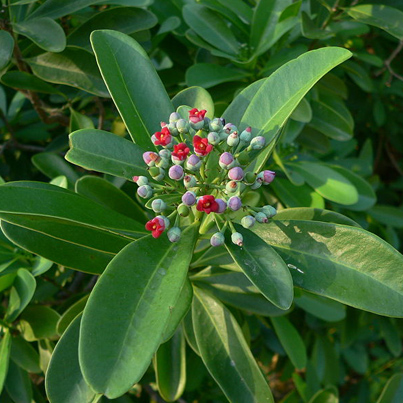Canella

Canella
Image source -
https://en.wikipedia.org/wiki/File:Canella_winterana_Guadeloupe.JPG - CC

Canella - General Info and History
The canella, better known as wild or white cinnamon, is a medium to large sized tree that thrives in several places in the Americas (especially in Florida), as well as some parts of Asia. The canella plant is prized not only for its cinnamon-like bark, which is often used as a substitute for authentic cinnamon bark, but for its beautiful, close-grained hardwood.
The canella is characterised by its scaly and highly aromatic bark which perhaps it's most unmistakable feature. Growing wild in the Americas since prior to the arrival of Europeans, it was one of the plants that immediately drew the attention of the newly arrived voyagers, as it had a highly discernable aroma redolent of cloves. It has large, broad, slightly rounded leaves that possess a lustrous sheen, and clustered fruits and bright, white or yellow flowers. While no record of the fruits ever being eaten by humans remains, it is possible that it had once been consumed by humans, as the fruits are so well-loved by the avian population of wherever canellas grow. When left to its own devices in the wild, the canella tree can grow to as tall as twenty-five to thirty feet. The canella tree is usually cultivated in smaller sizes as a source of its aromatic inner bark, which is used as a spice and medicine, while the larger ones are usually used for their beautiful and highly durable wood. [1]
Canella - Herbal Uses
The canella is most commonly employed, first and foremost as a spice, as its highly aromatic inner bark is used as a substitute for, or an alternative to cinnamon (Cinnamonum verum), due to its clove-like scent and 'warming' properties. Because of its use as an alternative to cinnamon (and, for its smell, even cloves), canella is often referred to by folkloric herbalists as 'wild cinnamon'. When harvested for its aromatic inner bark, the canella plant is usually kept trimmed into moderately manageable sizes (far less than its normal height if left wild), in order to facilitate for the easier acquisition of the inner bark in much the same vein as cinnamon cultivation and harvesting. No folkloric medicinal properties have been attributed to either its leaves or fruits, although the wood that it produces make for some of the most beautiful and durable sources of hardwoods, as it is close-grained, extremely tough, and very dense.
The inner bark of the canella, when dried in the same manner as cinnamon bark, produces a spice that looks, somewhat smells like, and tastes like cinnamon. This bark, like true cinnamon, may be used whole and made into weak or strong decoctions or otherwise ground and mixed into herbal infusions or otherwise incorporated as flavouring in a wide array of different sweet, savoury, and even spicy dishes. [2]
When used as a medicine, canella is usually made into a decoction employing (in most cases) whole 'quills', or, for faster results, it is usually used as an infusion by grinding the whole quill into a fine power. This may also be taken internally by encasing it in vegetable capsules, or otherwise mixed or incorporated liberally into foodstuffs. Some of the active compounds found in canella (eugeol; sesquiterpenes) have been shown to possess antimycotic effects. A strong decoction of canella quills alongside other medicinal herbs is often employed to treat whooping coughs and fevers, while a mild decoction is used to treat sore throat, hoarseness or loss of voice, colds, and minor stomach upsets (diarrhea / indigestion) as it is generally thought of to be a general tonic and warming drink. [3]
Canella also contains trace amounts of vitamins and minerals such as vitamins A, C, and E, and minerals magnesium, iron, manganese, and zinc. Because of this, it was used as a treatment for scurvy in the place of, or along with limes and other citrus fruits. [4] When infused into an oil, canella bark may also be used to help treat rheumatism and arthritis if applied to the affected area due to its warming ability. Also, both the tisane of canella and the canella-infused oil is said to improve the body's circulation. In the hybridized magickal practices of the Central and South America, the canella is also steeped in oil and employed as a love-charm. Despite its varied medicinal use, canella is not as frequently employed in herbal curatives outside of Central and South America, generally due to the preference for true cinnamon for both culinary and medicinal uses.
Canella - Scientific Studies And Research
A strong cytotoxic activity against the chloroquine-sensitive (CQS) strain of Plasmodium falciparum (D10) in vitro (IC50 2.53 mg/mL) by the Canella hexane extract was demonstrated in a 2010 US study. In this study, the extract was derived from Canella winterana leaves. [5] Plasmodium falciparum is a protozoan parasite responsible for majority of the cases (approximately 85%) of malaria [6] and thus holds a great part in the malaria burden faced in the tropics as well as morbidity and mortality. [7] Among the Plasmodium species that cause human malaria, P. falciparum is the most dreaded - and for good and logical reasons. In 2006, P. falciparum malaria was among the leading causes of death worldwide from a single infectious agent, and from an estimated 247 million malaria cases worldwide in 2006, 91% of these were due to P. falciparum, which means that P. falciparum is the culprit behind almost every malarial death. [8]
Canella - Phytochemistry / Active Components
Grace et al. (2010) had isolated five drimane-type sesquiterpenoids from the extract derived from Canella winterana leaves:
• 9-Epideoxymuzigadial
• 9-Deoxymuzigadial
• Muzigadial (known to have an antifungal activity against Candida albicans and an in vitro cytotoxic activity against Trypanosoma [9])
• 3-Beta-acetoxypolygodial
• Muzigodiol

Using bioassay-guided fractionation, the components were separated from each other in a step-by-step manner based on the differences in their physicochemical properties. Cytotoxicity tests were conducted on the first four sesquiterpenoids mentioned using Chinese hamster ovarian (CHO) cells. [5]
An earlier study by Pino, Rosado, and Fuentes (1998) on the leaf oil obtained from Canella winterana (L.) Gaertn, 70 components were observed to be present, although these chemical constituents exist in minute amounts (<2%). Below is a list of the major Canella winterana substances isolated from the Canella leaf oil through GC/MS analysis [10]:
• Caryophyllene oxide (37.4%; an oxygenated terpenoid with antifungal properties, especially against dermatophytes involved in onychomycosis [11]
• Myrcene (9.1%; a monoterpene with analgesic properties [12] and substantial protective effect against oxidant-induced genotoxicity [13])
• Linalool (8.5%; a terpene alcohol determined by several studies to reduce inflammation, [14] to induce autonomic deactivation and lower systolic blood pressure, [15] to reverse doxorubicin resistance in human breast adenocarcinoma cells, [16] and to inhibit in vitro nitric oxide formation, thus exerting antihyperalgesic and antinociceptive effects in different animal models [17])
• Beta-caryophyllene (5.6%; a bicyclic sesquiterpene with anti-inflammatory, antibiotic, antioxidant, anticarcinogenic, and local anaesthetic activities and with the ability to facilitate the passage of paclitaxel, a mitotic inhibitor used in chemotherapy, into the cells, thus potentiating the anticancer activity of the said drug [18])
Before that study, Al-Said, Khalifa, and El-Feraly (1989) already yielded a sesquiterpene compound known today as 4,13-a-epoxymuzigadial, which can be derived from the leaves of Canella winterana. [19] Similarly, Al-Said, El-Khawaja, El-Feraly, and Hufford (1990) isolated three drimane sesquiterpenes from the stem bark of Canella winterana collected in Florida. The sesquiterpenes are as follows: 9- deoxymuzigadial, 9-deoxyisomuzigadial, and 3fl-acetoxypolygodial, the first two being double bond isomers, which could only be separated from each other on silver nitrate-impregnated silica gel. The structures of these sesquiterpenes were elucidated from their spectral data. [20]
Names of Canella, Past and Present
Spanish: canella blanca / canella (lit. 'small cane')
French: canella blanche (lit. 'white cane')
English: white cinnamon / wild cinnamon / canella (adopted) / wild wood
Latin (esoteric): canella alba (lit. 'white cane')
Other names (various languages): barbasco / palo malambo / macambo
Latin (scientific nomenclature): Canella winteriana

References:
[1] https://en.wikipedia.org/wiki/Canella
[2] https://www.banderasnews.com/1007/hb-lesliekorn14.htm
[3] https://www.medicinenet.com/canella/supplements-vitamins.htm
[4] https://books.google.com/books?id=9XMs08j3od8C&pg=PA442
[5] Grace M.H. et al. (2010). Antiplasmodial and cytotoxic activities of drimane sesquiterpenes from Canella winterana. Natural Product Communications, 5(12): 1869-1872. Retrieved 23 February 2013 from https://www.ncbi.nlm.nih.gov/pubmed/21299109
[6] Plasmodium Falciparum - Malaria. Parasites in Humans. Retrieved 23 February 2013 from https://www.parasitesinhumans.org/plasmodium-falciparum-malaria.html
[7] Bousema T. & Drakeley C. (2011). Epidemiology and infectivity of Plasmodium falciparum and Plasmodium vivax gametocytes in relation to malaria control and elimination. Clinical Microbiology Reviews, 24(2): 377-410. doi: 10.1128/CMR.00051-10. Retrieved 23 February 2013 from https://www.ncbi.nlm.nih.gov/pubmed/21482730
[8] World Health Organization. (2006). Guidelines for the treatment of malaria. Geneva, WHO.
[9] Olila D., Opuda-Asibo J., & Olwa-Odyek. (2001). Bioassay-guided studies on the cytotoxic and in vitro trypanocidal activities of a sesquiterpene (Muzigadial) derived from a Ugandan medicinal plant (Warburgia ugandensis). African Health Sciences, 1(1): 12-15. Retrieved 23 February 2013 from https://www.bioline.org.br/pdf?hs01006
[10] Pino J.A., Rosado A., & Fuentes V. (1998). Canella winterana (L.) Gaertn. from Cuba. Journal of Essential Oil Research, 10(3): 311-312. Retrieved 23 February 2013 from https://europepmc.org/abstract/AGR/IND21960383/reload=0;jsessionid=QFzvreXaPIfOBuDuhEIr.0
[11] Yang D., Michel L., Chaumont J.P., & Millet-Clerc J. (1999). Use of caryophyllene oxide as an antifungal agent in an in vitro experimental model of onychomycosis. Mycopathologia, 148(2): 79-82. Retrieved 23 February 2013 from https://www.ncbi.nlm.nih.gov/pubmed/11189747
[12] da-Silva V.A. (1991). Neurobehavioral study of the effect of beta-myrcene on rodents. Brazilian Journal of Medical and Biological Research, 24(8): 827-831. Retrieved 23 February 2013 from https://www.ncbi.nlm.nih.gov/pubmed/1797273
[13] Mitic-Culafic D. et al. (2009). Protective effect of linalool, myrcene and eucalyptol against t-butyl hydroperoxide induced genotoxicity in bacteria and cultured human cells. Food and Chemical Toxicology, 47(1): 260-266. doi: 10.1016/j.fct.2008.11.015. Retrieved 23 February 2013 from https://www.ncbi.nlm.nih.gov/pubmed/19049815
[14] Peana A.T., D'Aquila P.S., Panin F., Serra G., Pippia P., & Moretti M.D. (2002). Anti-inflammatory activity of linalool and linalyl acetate constituents of essential oils. Phytomedicine, 9(8): 721-726. Retrieved 23 February 2013 from https://www.ncbi.nlm.nih.gov/pubmed/12587692
[15] Heuberger E., Redhammer S., & Buchbauer G. (2004). Transdermal absorption of (-)-linalool induces autonomic deactivation but has no impact on ratings of well-being in humans. Neuropsychopharmacology, 29(10): 1925-1932. Retrieved 23 February 2013 from https://www.ncbi.nlm.nih.gov/pubmed/15238993
[16] Ravizza R., Gariboldi M.B., Molteni R., & Monti E. (2008). Linalool, a plant-derived monoterpene alcohol, reverses doxorubicin resistance in human breast adenocarcinoma cells. Oncology Reports, 20(3): 625-630. Retrieved 23 February 2013 from https://www.ncbi.nlm.nih.gov/pubmed/18695915
[17] Peana A.T., Marzocco S., Popolo A., & Pinto A. (2006). (-)-Linalool inhibits in vitro NO formation: Probable involvement in the antinociceptive activity of this monoterpene compound. Life Sciences, 78(7): 719-723. Retrieved 23 February 2013 from https://www.ncbi.nlm.nih.gov/pubmed/16137709
[18] Legault J. & Pichette A. (2007). Potentiating effect of beta-caryophyllene on anticancer activity of alpha-humulene, isocaryophyllene and paclitaxel. Journal of Pharmacy and Pharmacology, 59(12): 1643-1647. Retrieved 23 February 2013 from https://www.ncbi.nlm.nih.gov/pubmed/18053325
[19] Al-Said M.S., Khalifa S.I., & El-Feraly F.S. (1989). 4,13-a-epoxymuzigadial, a sesquiterpene from Canella winterana. Phytochemistry, 28(1): 297-298. Retrieved 23 February 2013 from https://www.sciencedirect.com/science/article/pii/003194228985068X
[20] Al-Said M.S., El-Khawaja S.M., El-Feraly F.S., & Hufford C.D. (1990). 9-Deoxy drimane sesquiterpenes from Canella winterana. Phytochemistry, 29(3): 975-977. Retrieved 23 February 2013 from https://www.sciencedirect.com/science/article/pii/003194229080059P
Main article researched and created by Alexander Leonhardt, scientific studies by Dan Ablir.
© herbshealthhappiness.com


1. Famous Chef Sheds 60lbs Researching New Paleo Recipes: Get The Cookbook FREE Here
2. #1 muscle that eliminates joint and back pain, anxiety and looking fat
3. Drink THIS first thing in the morning (3 major benefits)
4. [PROOF] Reverse Diabetes with a "Pancreas Jumpstart"
5. Why Some People LOOK Fat that Aren't
6. Amazing Secret Techniques To Protect Your Home From Thieves, Looters And Thugs
7. The #1 WORST food that CAUSES Faster Aging (beware -- Are you eating this?)
If you enjoyed this page:





























